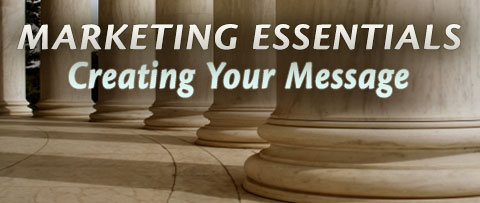Here's part 5 in our series this week from Small Fuel:
Marketing Essentials: Creating the Perfect Message
Reaching consumers with your message is one of the top Marketing Essentials. If people don't hear what you're saying and see what you're showing them, why would they do business with you?
But what is your marketing message? What are you trying to get across to people? It's simple: You know their problem, you have the solution, and you are the best business to buy it from.
That's easier said than done, of course. It's difficult for many small business owners to figure out exactly how to market that they can solve problems. One of the most common mistakes is touting features or going on about being the best.
Everyone is the best these days. No one wants to hear it again. And yet, you need people to hear you, feel your message and believe it. How?
Creating a solid marketing message makes a difference in whether consumers pay attention to you, whether they trust you and whether they decide to buy. It combines specific elements to:
- Grab people's attention and interest
- Tell consumers how you solve their problem
- Convey why people should trust you
- Indicate why you're different or special
- Show why people should choose you
By following just a few easy steps, you can compel interest and evoke the power of a message that people not only hear but feel as well.
Identify your target market
Every business has a target market, and no, it isn't everyone. Before anything else, you must know the consumer who will buy from you intimately.
What is this ideal customer like? What is his or her personality? What demographic does the individual belong to and do you know his or her realistic income? What kind of shopping preferences does the customer have?
Find your market's needs
Now that you know your ideal customer, identify this person's problems. Everyone suffers, whether it is mental, physical or emotional - and people want to ease suffering quickly. If they know you care, you have a better chance of making them a customer.
Know your customer's problem. Make sure that your message tells consumers that you understand their pain and that you empathize with their suffering. How do they hurt? What are they feeling?
Offering a solution
You've identified your target consumer. You know the person's pain and problem. Now give them the solution and present the cure to their suffering. Address the situation in a way that makes the consumer relive his or her pain so that it is clearly felt – and so that the person sees you can ease the hurting.
Benefits tie in closely at this point. The ways you change a person's life convince consumers that you offer what they need. Your benefits establish that you can remove the suffering and help consumers achieve their goals.
Minimize the risk
Remove as much risk as you can when presenting your solution. Consumers need to feel that the end of their anguish will happen quickly and easily. Banish the uncertainties and make your solution one they can implement right away, if possible.
Also, remove any barriers to taking action. People are increasingly busy and tired of jumping through hoops to get what they want. Make it easy for people to choose you. Keep in mind, too, that the more you do for them, the happier they'll be – because it's easier to pay someone to help us than to help ourselves.
Show them proof
People are funny creatures sometimes. No one likes to be the first to try something new or the only one standing in line. Consumers are more likely to buy if someone has already bought and had good results and a great experience. If it works for others, it'll work for them.
Show your target market that people in the very same situation with identical pain have had positive results. Present proof that what you sell works, that it eases suffering and offers the cure. Word of mouth referral is the best marketing.
This is where testimonials, before-and-after stories, case studies and statistics come into play -- the more measurable and credible the proof, the better. It makes your message more believable and backs up your promises.
Be different
You have competition out there, offering the same solutions that you do. What makes you different? Why is your solution better? Why should people choose you over someone else?
This doesn't mean bad-mouthing the competition or putting them down. It's often a better idea to avoid comparing your solutions to everyone else's to boost your reputation. All you need to do is know why you're different - and communicate those differences clearly.
A solid marketing message captures the elements of knowing your audience, their problems, and your solution. Communicate these elements to consumers in a credible, believable manner.
Use your message everywhere -- on fliers, in your website copy, on your business card -- and you'll quickly be on your way to small business success.
Next week we're going to have a can't-miss Marketing Essentials post about websites, so make sure you come back and check it out. Oh, and feel free to subscribe too.
Sphere: Related Content













No comments:
Post a Comment